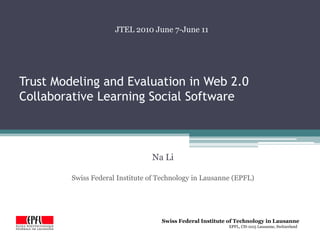
Jtel 2010 na li
- 1. Trust Modeling and Evaluation in Web 2.0 Collaborative Learning Social Software JTEL 2010 June 7-June 11 Na Li Swiss Federal Institute of Technology in Lausanne (EPFL)
- 2. Outline Research Questions Current Progress Future Work
- 3. Research Questions Lots of Web 2.0 learning environments bring about large amount of user-generated content What should we trust? Who should we trust? RSS Feeds Pictures Pictures Wiki Pages Documents Videos
- 4. Research Questions Trust Measurement Evaluate quality of user-generated content Recommend useful resources Privacy management
- 5. Current Progress Trust-based rating prediction Quality evaluation in open learning environment Filter helpful learning resources, people and group activities
- 7. Trust-Based Rating Prediction Approach Trust measurement Multi-relational trust metric Build a “Web of Trust” for a particular user using heterogeneous types of relationships Trust How Much?
- 8. Trust-Based Rating Prediction Approach Trust propagation Propagation distance (PD) Bob Commented by Article Rated by Sara Create Is Member Has Member French Learning Activity Luis Alice Rate Video Rated by Ben Created by Jack Propagate Propagate Propagate PD
- 9. Trust-Based Rating Prediction Approach Rating prediction from a user to an item Using user’s “Web of Trust” People in “Web of Trust” are seen as trustable Average of all the rating scores given by trustable people, weighted by their trust value
- 10. Evaluation and Results Using Remashed data set 50 users, 6000 items, 3000 tags and 450 ratings “Leave-one-out” method Compare “predicted score – actual score” deviation of trust-based prediction and simple average
- 11. Evaluation and Results Change parameters Weights for relationships doesn’t make a significant difference in rating prediction Increasing size of trust network might add noise, lead to bigger prediction error
- 12. Future Work Future deploy and evaluation will be conducted in a collaborative learning platform, namely Graaasp(graaasp.epfl.ch) Trust-based privacy management
- 13. Questions?
Notes de l'éditeur
- Trust propagates layer by layer, until reaching the propagate distance we predefine.A “Web of Trust” is constructed in this way.
- Different weights and propagate distances are tried.On this test set, the change of trust weights for relationships doesn’t make a significant difference in the results of rating prediction.We get an optimal propagate distance value, which indicates that, instead of improving the prediction results, increasing the size of trust network might add noise, leading to bigger prediction error.
- Different weights and propagate distances are tried.On this test set, the change of trust weights for relationships doesn’t make a significant difference in the results of rating prediction.We get an optimal propagate distance value, which indicates that, instead of improving the prediction results, increasing the size of trust network might add noise, leading to bigger prediction error.